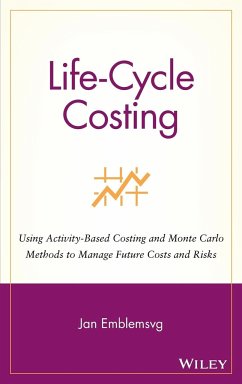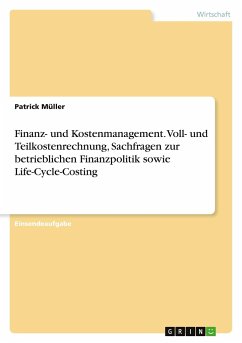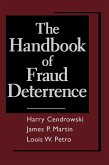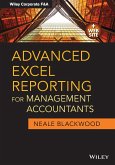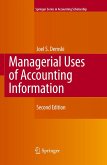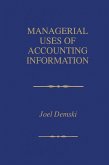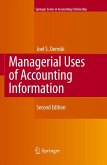Jan Emblemsvag
Life-Cycle Costing
Using Activity-Based Costing, Risk Management, and Monte Carlo Simulations
Jan Emblemsvag
Life-Cycle Costing
Using Activity-Based Costing, Risk Management, and Monte Carlo Simulations
- Gebundenes Buch
- Merkliste
- Auf die Merkliste
- Bewerten Bewerten
- Teilen
- Produkt teilen
- Produkterinnerung
- Produkterinnerung
Most cost management efforts concern understanding the past but this title focuses on future costs, their uncertainties, and risks. It presents a new approach toward life cycle costing based on the principles of activity-based costing, uncertainty and risk management, and Monte Carlo methods. This book provides a how-to methodology and shows readers that they can perform any type of cost management better than before if they introduce uncertainty into their models and exploit to the maximum what happens.
Andere Kunden interessierten sich auch für
![Finanz- und Kostenmanagement. Voll- und Teilkostenrechnung, Sachfragen zur betrieblichen Finanzpolitik sowie Life-Cycle-Costing Finanz- und Kostenmanagement. Voll- und Teilkostenrechnung, Sachfragen zur betrieblichen Finanzpolitik sowie Life-Cycle-Costing]() Patrick MüllerFinanz- und Kostenmanagement. Voll- und Teilkostenrechnung, Sachfragen zur betrieblichen Finanzpolitik sowie Life-Cycle-Costing13,95 €
Patrick MüllerFinanz- und Kostenmanagement. Voll- und Teilkostenrechnung, Sachfragen zur betrieblichen Finanzpolitik sowie Life-Cycle-Costing13,95 €![The Handbook of Fraud Deterrence The Handbook of Fraud Deterrence]() Harry CendrowskiThe Handbook of Fraud Deterrence142,99 €
Harry CendrowskiThe Handbook of Fraud Deterrence142,99 €![Advanced Excel Reporting for Management Accountants Advanced Excel Reporting for Management Accountants]() Neale BlackwoodAdvanced Excel Reporting for Management Accountants50,99 €
Neale BlackwoodAdvanced Excel Reporting for Management Accountants50,99 €![Managerial Uses of Accounting Information Managerial Uses of Accounting Information]() Joel DemskiManagerial Uses of Accounting Information200,99 €
Joel DemskiManagerial Uses of Accounting Information200,99 €![Managerial Uses of Accounting Information Managerial Uses of Accounting Information]() Joel DemskiManagerial Uses of Accounting Information110,99 €
Joel DemskiManagerial Uses of Accounting Information110,99 €![Managerial Uses of Accounting Information Managerial Uses of Accounting Information]() Joel DemskiManagerial Uses of Accounting Information130,99 €
Joel DemskiManagerial Uses of Accounting Information130,99 €![The Abu-Ghazaleh English-Arabic Dictionary of Accountancy The Abu-Ghazaleh English-Arabic Dictionary of Accountancy]() The Abu-Ghazaleh English-Arabic Dictionary of Accountancy51,99 €
The Abu-Ghazaleh English-Arabic Dictionary of Accountancy51,99 €-
-
-
Most cost management efforts concern understanding the past but this title focuses on future costs, their uncertainties, and risks. It presents a new approach toward life cycle costing based on the principles of activity-based costing, uncertainty and risk management, and Monte Carlo methods. This book provides a how-to methodology and shows readers that they can perform any type of cost management better than before if they introduce uncertainty into their models and exploit to the maximum what happens.
Hinweis: Dieser Artikel kann nur an eine deutsche Lieferadresse ausgeliefert werden.
Hinweis: Dieser Artikel kann nur an eine deutsche Lieferadresse ausgeliefert werden.
Produktdetails
- Produktdetails
- Verlag: WILEY & SONS
- Seitenzahl: 336
- Erscheinungstermin: 14. März 2003
- Englisch
- Abmessung: 240mm x 161mm x 23mm
- Gewicht: 677g
- ISBN-13: 9780471358855
- ISBN-10: 0471358851
- Artikelnr.: 11406524
- Herstellerkennzeichnung
- Libri GmbH
- Europaallee 1
- 36244 Bad Hersfeld
- gpsr@libri.de
- Verlag: WILEY & SONS
- Seitenzahl: 336
- Erscheinungstermin: 14. März 2003
- Englisch
- Abmessung: 240mm x 161mm x 23mm
- Gewicht: 677g
- ISBN-13: 9780471358855
- ISBN-10: 0471358851
- Artikelnr.: 11406524
- Herstellerkennzeichnung
- Libri GmbH
- Europaallee 1
- 36244 Bad Hersfeld
- gpsr@libri.de
JAN EMBLEMSVÅG is a management consultant with Det Norske Veritas Consulting, where he works on cost management, risk management, and business development projects. Formerly, he was a partner with Considium Consulting Group AS. He is coauthor, with Bert A. Bras, of Activity-Based Cost and Environmental Management: A Different Approach to the ISO 14000 Compliance.
Preface.
Acknowledgments.
1. Introduction.
What Does It Cost?
The Role of Life-Cycle Costing.
Why Activity-Based Life-Cycle Costing?
Notes.
2. Basics of Life-Cycle Costing.
What Is a Life Cycle?
What Is a Cost?
Four Ways of LCC.
Notes.
3. Uncertainty Analysis and Risk Management.
What are Risk and Uncertainty?
Uncertainty, Risk, and Utility.
Common Ways of Analyzing Risk and Uncertainty.
How Belief Sheds Light on Risk and Uncertainty.
Reduce Risk by Introducing Uncertainty: How Monte Carlo Methods Work.
Traditional Risk Management.
Notes.
4. Activity-Based Costing.
Motivating Example.
Activity-Based Costing.
ABC Example and Case Study.
From the Trenches.
Notes.
5. Activity-Based Life-Cycle Costing.
Step 1: Define the Scope of the Model and the Corresponding Cost Objects.
Step 2: Obtain and Clean Bill of Materials for All Cost Objects.
Step 3: Identify and Quantify the Resources.
Step 4: Create an Activity Hierarchy and Network.
Step 5: Identify and Quantify Resource Drivers, Activity Drivers, and Their
Intensities.
Step 6: Identify the Relationships between Activity Drivers and Design
Changes.
Step 7: Model the Uncertainty.
Step 8: Estimate the Bill of Activities.
Step 9: Estimate the Cost of Cost Objects and Their Performance Measures.
Step 10: Perform Monte Carlo Simulations and Relevant Analyses.
Further Explanation Regarding Some Steps.
Notes.
6. Case Study: Life-Cycle Costing and Tire Disposal.
What the Decision Is About.
Traditional LCC Implementation.
Activity-Based LCC Implementation.
Discussion.
Closure.
Epilogue.
Notes.
7. Activity-Based Life-Cycle Costing for Platform Supply Vessels.
Operating a Platform Supply Vessel.
Problem Statement and System Boundaries.
Information Sources.
Activity-Based LCC Model Implementation and Results.
Identifying the Major Operational Risks.
Closure.
Notes.
8. Activity-Based Life-Cycle Costing at WagonHo!
WagonHo!'s New Strategy and Business Idea.
Developing an Activity-Based LCC Model.
Results and How to Use Them.
Closure.
Notes.
9. From Hindsight to Foresight.
Activity-Based LCC Revisited.
Ideas for the Future.
Some Thoughts at the End.
Notes.
Appendix A Monte Carlo Simulation Example.
Problem Definition.
Hypotheses to Be Tested.
Results and Discussion.
Appendix B SFI Group System.
Glossary.
Acronyms.
Index.
Acknowledgments.
1. Introduction.
What Does It Cost?
The Role of Life-Cycle Costing.
Why Activity-Based Life-Cycle Costing?
Notes.
2. Basics of Life-Cycle Costing.
What Is a Life Cycle?
What Is a Cost?
Four Ways of LCC.
Notes.
3. Uncertainty Analysis and Risk Management.
What are Risk and Uncertainty?
Uncertainty, Risk, and Utility.
Common Ways of Analyzing Risk and Uncertainty.
How Belief Sheds Light on Risk and Uncertainty.
Reduce Risk by Introducing Uncertainty: How Monte Carlo Methods Work.
Traditional Risk Management.
Notes.
4. Activity-Based Costing.
Motivating Example.
Activity-Based Costing.
ABC Example and Case Study.
From the Trenches.
Notes.
5. Activity-Based Life-Cycle Costing.
Step 1: Define the Scope of the Model and the Corresponding Cost Objects.
Step 2: Obtain and Clean Bill of Materials for All Cost Objects.
Step 3: Identify and Quantify the Resources.
Step 4: Create an Activity Hierarchy and Network.
Step 5: Identify and Quantify Resource Drivers, Activity Drivers, and Their
Intensities.
Step 6: Identify the Relationships between Activity Drivers and Design
Changes.
Step 7: Model the Uncertainty.
Step 8: Estimate the Bill of Activities.
Step 9: Estimate the Cost of Cost Objects and Their Performance Measures.
Step 10: Perform Monte Carlo Simulations and Relevant Analyses.
Further Explanation Regarding Some Steps.
Notes.
6. Case Study: Life-Cycle Costing and Tire Disposal.
What the Decision Is About.
Traditional LCC Implementation.
Activity-Based LCC Implementation.
Discussion.
Closure.
Epilogue.
Notes.
7. Activity-Based Life-Cycle Costing for Platform Supply Vessels.
Operating a Platform Supply Vessel.
Problem Statement and System Boundaries.
Information Sources.
Activity-Based LCC Model Implementation and Results.
Identifying the Major Operational Risks.
Closure.
Notes.
8. Activity-Based Life-Cycle Costing at WagonHo!
WagonHo!'s New Strategy and Business Idea.
Developing an Activity-Based LCC Model.
Results and How to Use Them.
Closure.
Notes.
9. From Hindsight to Foresight.
Activity-Based LCC Revisited.
Ideas for the Future.
Some Thoughts at the End.
Notes.
Appendix A Monte Carlo Simulation Example.
Problem Definition.
Hypotheses to Be Tested.
Results and Discussion.
Appendix B SFI Group System.
Glossary.
Acronyms.
Index.
Preface.
Acknowledgments.
1. Introduction.
What Does It Cost?
The Role of Life-Cycle Costing.
Why Activity-Based Life-Cycle Costing?
Notes.
2. Basics of Life-Cycle Costing.
What Is a Life Cycle?
What Is a Cost?
Four Ways of LCC.
Notes.
3. Uncertainty Analysis and Risk Management.
What are Risk and Uncertainty?
Uncertainty, Risk, and Utility.
Common Ways of Analyzing Risk and Uncertainty.
How Belief Sheds Light on Risk and Uncertainty.
Reduce Risk by Introducing Uncertainty: How Monte Carlo Methods Work.
Traditional Risk Management.
Notes.
4. Activity-Based Costing.
Motivating Example.
Activity-Based Costing.
ABC Example and Case Study.
From the Trenches.
Notes.
5. Activity-Based Life-Cycle Costing.
Step 1: Define the Scope of the Model and the Corresponding Cost Objects.
Step 2: Obtain and Clean Bill of Materials for All Cost Objects.
Step 3: Identify and Quantify the Resources.
Step 4: Create an Activity Hierarchy and Network.
Step 5: Identify and Quantify Resource Drivers, Activity Drivers, and Their
Intensities.
Step 6: Identify the Relationships between Activity Drivers and Design
Changes.
Step 7: Model the Uncertainty.
Step 8: Estimate the Bill of Activities.
Step 9: Estimate the Cost of Cost Objects and Their Performance Measures.
Step 10: Perform Monte Carlo Simulations and Relevant Analyses.
Further Explanation Regarding Some Steps.
Notes.
6. Case Study: Life-Cycle Costing and Tire Disposal.
What the Decision Is About.
Traditional LCC Implementation.
Activity-Based LCC Implementation.
Discussion.
Closure.
Epilogue.
Notes.
7. Activity-Based Life-Cycle Costing for Platform Supply Vessels.
Operating a Platform Supply Vessel.
Problem Statement and System Boundaries.
Information Sources.
Activity-Based LCC Model Implementation and Results.
Identifying the Major Operational Risks.
Closure.
Notes.
8. Activity-Based Life-Cycle Costing at WagonHo!
WagonHo!'s New Strategy and Business Idea.
Developing an Activity-Based LCC Model.
Results and How to Use Them.
Closure.
Notes.
9. From Hindsight to Foresight.
Activity-Based LCC Revisited.
Ideas for the Future.
Some Thoughts at the End.
Notes.
Appendix A Monte Carlo Simulation Example.
Problem Definition.
Hypotheses to Be Tested.
Results and Discussion.
Appendix B SFI Group System.
Glossary.
Acronyms.
Index.
Acknowledgments.
1. Introduction.
What Does It Cost?
The Role of Life-Cycle Costing.
Why Activity-Based Life-Cycle Costing?
Notes.
2. Basics of Life-Cycle Costing.
What Is a Life Cycle?
What Is a Cost?
Four Ways of LCC.
Notes.
3. Uncertainty Analysis and Risk Management.
What are Risk and Uncertainty?
Uncertainty, Risk, and Utility.
Common Ways of Analyzing Risk and Uncertainty.
How Belief Sheds Light on Risk and Uncertainty.
Reduce Risk by Introducing Uncertainty: How Monte Carlo Methods Work.
Traditional Risk Management.
Notes.
4. Activity-Based Costing.
Motivating Example.
Activity-Based Costing.
ABC Example and Case Study.
From the Trenches.
Notes.
5. Activity-Based Life-Cycle Costing.
Step 1: Define the Scope of the Model and the Corresponding Cost Objects.
Step 2: Obtain and Clean Bill of Materials for All Cost Objects.
Step 3: Identify and Quantify the Resources.
Step 4: Create an Activity Hierarchy and Network.
Step 5: Identify and Quantify Resource Drivers, Activity Drivers, and Their
Intensities.
Step 6: Identify the Relationships between Activity Drivers and Design
Changes.
Step 7: Model the Uncertainty.
Step 8: Estimate the Bill of Activities.
Step 9: Estimate the Cost of Cost Objects and Their Performance Measures.
Step 10: Perform Monte Carlo Simulations and Relevant Analyses.
Further Explanation Regarding Some Steps.
Notes.
6. Case Study: Life-Cycle Costing and Tire Disposal.
What the Decision Is About.
Traditional LCC Implementation.
Activity-Based LCC Implementation.
Discussion.
Closure.
Epilogue.
Notes.
7. Activity-Based Life-Cycle Costing for Platform Supply Vessels.
Operating a Platform Supply Vessel.
Problem Statement and System Boundaries.
Information Sources.
Activity-Based LCC Model Implementation and Results.
Identifying the Major Operational Risks.
Closure.
Notes.
8. Activity-Based Life-Cycle Costing at WagonHo!
WagonHo!'s New Strategy and Business Idea.
Developing an Activity-Based LCC Model.
Results and How to Use Them.
Closure.
Notes.
9. From Hindsight to Foresight.
Activity-Based LCC Revisited.
Ideas for the Future.
Some Thoughts at the End.
Notes.
Appendix A Monte Carlo Simulation Example.
Problem Definition.
Hypotheses to Be Tested.
Results and Discussion.
Appendix B SFI Group System.
Glossary.
Acronyms.
Index.

